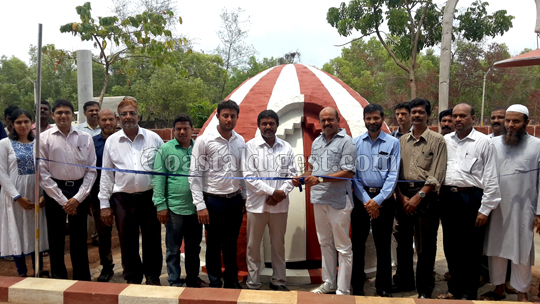Mangaluru, May 22: A project exhibition of Ogival Shell structure constructed by Thariq Aziz, an M.Tech student of Srinivas School of Engineering Mukka, was recently inaugurated by local MLA BA Mohiuddin Bava at Dakshina Kannada Nirmithi Kendra, Surathkal, here.
The eco friendly, low cost, bud' shaped pointed shell structure was constructed without using steel and concrete which can withstand all types of climatic conditions was executed under the advice of Dr. K S Jagadish, Professor Emeritus, IISc Bengaluru and under the guidance of Prof. Subramanya Bhat P of SSE Mukka.

He said that by adopting this construction technique, around 30-40% basic construction materials can be saved which in turn help in conservation of energy. This type of structure can be constructed at religious places, tourism projects, resorts, rehabilitation and housing projects. Steering and tilting rod technology was developed and incorporated in this project which can rotate 360 degrees to maintain same radius at different levels which helps in maintaining bud' shaped pointed shell and also ease in construction.
Construction of bud' shape using concrete is a tedious job, since it includes sloping formwork and curved reinforcements. Hence the masonry construction of this nature can be a good alternate to RCC which bears good strength and also act as thermal insulator, he said.
Mr Mohiuddin Bava appreciated the project and said that this project is proved to be green construction as very less quantity of cement is consumed, and no steel and concrete. MLA assured that he will provide all necessary support and assistance from the state government to motivate the research attitude among students community of Srinivas School of Engineering.
Er Rajendra Kalbhavi – Project Director of DK Nirmithi Kendra; Dr. K S Babu Narayan – Coordinator of DK Nirmithi Kendra; Dr. Subhash Yaragal – Professor, Dept. of Civil Engg, NITK Surathkal; Dr. Shreeprakash B – Principal, Srinivas School of Engineering; Dr.Ramakrishna Hegde – Vice Principal; Prof. Subramanya Bhat P – Project Guide; Prof. Shrinath Rao K and Ms. Aneesha Thodthillaya of Srinivas School of Engineering; Er Sharat of DK Nirmithi Kendra; Mr. T Habeeb – Project Coordinator, Boskalis Westminister UK; Er Mohammed Shameer – Project Engineer, Saudi Oger Ltd. were present.








Comments
All d Best, Keep it up, At least try more innovation to save our poor mankind those who are struggling to build their own shelter in small amount.. all d best. If succeed in good deeds, you will rewarded not only by people, by almighty Great Allah(God).
congrats tariq aziz.....
Masha Allah, Great Job Keep it up, Forget Second Floor!!!
Masha Allah.Great, expecting more innovations
Thanks alot each and every one for your valuable comments and best wishes to me. Regarding the ogival shell it can be constructed to any diameter and height. It is not only feasible to construct in religious centers it can also be designed to a independent houses, restaurants, resorts, office, a coffee shop etc. And when it comes to having second floor we can construct a loft and make use of the ample space.
Bro,, You have done remarkably well at such a young age. Congratulations for achieving so much on your own stream.
Masha Allah Tariq.. Happy for you buddy!!
Good to see some innovative ideas..
Make in India !!
@karan rao.
Read the report properly before posting a comment. he is not going to build your house. that's a dome. you can construct on your temple.
moreover its a project work. you need not to worry much.
Congradulation Thariq Azeez. keep it up. all the best.
Nice! all the best.
This is just awesome. Good job tariq. Can be constructed in rural areas too.
Well done, good work Aziz. Looking forward for your future innovations.
well done Brother. Expecting more innovations in such eco freindly structures.
how u will you build second floor in such counstructions? middle class people cant afford it as land prices are very high in the situation. coz if they want to construct this type of house they need more spaces. its a pro rich project.
All the best Tariq.
Masha Allah, great work n keep going bro Thariq!!!!may almighty Allah grant you more success ahead...
Add new comment